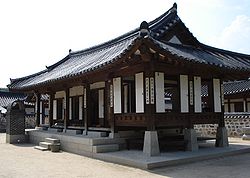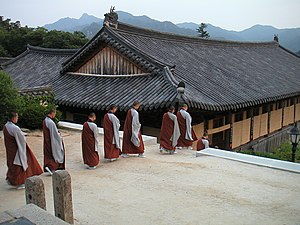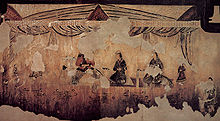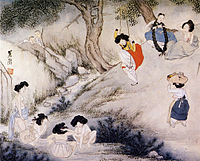The current political separation of North and South Korea has resulted in divergence in modern Korean cultures; nevertheless, the traditional culture of Korea is historically shared by both states.
Traditional arts
Dance

As with music, there is a distinction between court dance and folk dance. Common court dances are
jeongjaemu (정재무) performed at banquets, and
ilmu (일무), performed at Korean Confucian rituals.
Jeongjaemu is divided into native dances (향악정재,
hyangak jeongjae) and forms imported from Central Asia and China (당악정재,
dangak jeongjae).
Ilmu are divided into civil dance (문무,
munmu) and military dance (무무,
mumu). Many mask dramas and mask dances are performed in many regional areas of Korea.
The traditional clothing is the genja, it is a special kind of dress
that women wear on festivals. It is pink with multiple symbols around
the neck area.
Traditional choreography of court dances is reflected in many contemporary productions.
Painting
The earliest paintings found on the Korean peninsula are petroglyphs of prehistoric times. With the arrival of Buddhism from India via China,
different techniques were introduced. These techniques quickly
established themselves as the mainstream techniques, but indigenous
techniques still survived.
There is a tendency towards naturalism with subjects such as
realistic landscapes, flowers and birds being particularly popular. Ink
is the most common material used, and it is painted on mulberry paper or
silk.
In the 18th century indigenous techniques were advanced, particularly in calligraphy and seal engraving.
Arts are both influenced by tradition and realism in North Korea.
For example, Han’s near-photographic "Break Time at the Ironworks"
shows muscular men dripping with sweat and drinking water from tin cups
at a sweltering foundry. Jeong Son’s "Peak Chonnyo of Mount Kumgang" is a classical Korean landscape of towering cliffs shrouded by mists.
Crafts

There is a unique set of handicrafts produced in Korea. Most of the handicrafts are created for a particular everyday use, often giving priority to the practical use rather than aesthetics. Traditionally, metal, wood, fabric, lacquerware, and earthenware were the main materials used, but later glass, leather or paper have sporadically been used.
Ancient handicrafts, such as red and black pottery, share similarities with pottery of Chinese cultures along the Yellow River. The relics found of the Bronze Age, however, are distinctive and more elaborate.
Many sophisticated and elaborate handicrafts have been excavated,
including gilt crowns, patterned pottery, pots or ornaments. During the
Goryeo period the use of bronze was advanced. Brass, that is copper with one third zinc, has been a particularly popular material. The dynasty, however, is renowned for its use of celadon ware.
During the Joseon period popular handicrafts were made of porcelain
and decorated with blue painting. Woodcraft was also advanced during
that period. This led to more sophisticated pieces of furniture,
including wardrobes, chests, tables or drawers.
Ceramics
The use of earthenware on the Korean peninsula goes back to the Neolithic. The history of Korean Ceramics
is long and includes both Korean pottery a later development after the
traditional use of coils and hammered clay to create early votive and
sculptural artifacts. During the Three Kingdoms period, pottery was
advanced in Silla. The pottery was fired using a deoxidizing flame, which caused the distinctive blue grey celadon color. The surface was embossed with various geometrical patterns.

In the Goryeo period jade green celadon ware became more popular. In
the 12th century sophisticated methods of inlaying were invented,
allowing more elaborate decorations in different colours. In Arts of
Korea, Evelyn McCune states, "During the twelfth century, the production
of ceramic ware reached its highest refinement. Several new varieties
appeared simultaneously in the quarter of a century, one of which, the
inlaid ware must be considered a Korean invention."
Neither the Chinese nor the Japanese had produced inlaid celadon, which
was unique to Goryeo wares. William Bowyer Honey of the Victoria and
Albert Museum of England, who after World War II wrote, "The best Corean
(Korean) wares were not only original, they are the most gracious and
unaffected pottery ever made. They have every virtue that pottery can
have. This Corean pottery, in fact, reached heights hardly attained even
by the Chinese."
White porcelain
became popular in the 15th century. It soon overtook celadon ware.
White porcelain was commonly painted or decorated with copper.
During the Imjin wars in the 16th century, Korean potters were brought back to Japan where they heavily influenced Japanese ceramics.
Many Japanese pottery families today can trace their art and ancestry
to these Korean potters whom the Japanese captured by the thousands
during its repeated conquests of the Korean peninsula.
In the late Joseon period (late 17th century) blue-and-white
porcelain became popular. Designs were painted in cobalt blue on white
porcelain.
Lifestyle
Homes

Sites of residence are traditionally selected using traditional geomancy. Although geomancy had been a vital part of Korean culture and Korean Shamanism since prehistoric times, geomancy was later re-introduced by China during the Three Kingdoms period of Korea's history.
A house should be built against a hill and face south to receive as
much sunlight as possible. This orientation is still preferred in modern
Korea. Geomancy also influences the shape of the building, the
direction it faces and the material it is built of.

Traditional Korean houses can be structured into an inner wing (안채,
anchae) and an outer wing (사랑채,
sarangchae).
The individual layout largely depends on the region and the wealth of
the family. Whereas aristocrats used the outer wing for receptions,
poorer people kept cattle in the
sarangchae. The wealthier a
family, the larger the house. However, it was forbidden to any family
except for the king to have a residence of more than 99
kan. A
kan is the distance between two pillars used in traditional houses.
The inner wing normally consisted of a living room, a kitchen and a
wooden-floored central hall. More rooms may be attached to this. Poorer
farmers would not have any outer wing. Floor heating (온돌,
ondol) has been used in Korea since prehistoric times. The main building materials are wood, clay, tile, stone, and thatch.
Because wood and clay were the most common materials used in the past
not many old buildings have survived into present times. Today, however,
people live in apartments and more modernized houses.
Gardens

The principles of temple gardens and private gardens are the same. Korean gardening in East Asia is influenced by primarily Korean Shamanism and Korean folk religion.
Shamanism emphasizes nature and mystery, paying great attention to the
details of the layout. In contrast to Japanese and Chinese gardens which
fill a garden with man made elements, traditional Korean gardens avoid artificialities, trying to make a garden more natural than nature.
The lotus
pond is an important feature in the Korean garden. If there is a
natural stream, often a pavilion is built next to it, allowing the
pleasure of watching the water. Terraced flower beds are a common feature in traditional Korean gardens.
The Poseokjeong site near Gyeongju was built in the Silla
period. It highlights the importance of water in traditional Korean
gardens. The garden of Poseokjeong features an abalone-shaped
watercourse. During the last days of the Silla kingdom, the king's guests would sit along the watercourse and chat while wine cups were floated during banquets.
Clothing
The traditional dress known as
hanbok (한복, 韓服) (known as
joseonot [조선옷] in the DPRK) has been worn since ancient times. The
hanbok consists of a shirt (
jeogori) and a skirt (
baji). The traditional hat is called
gwanmo and special meaning is attached to this piece of clothing.

According to social status, Koreans used to dress differently, making
clothing an important mark of social rank. Impressive, but sometimes
cumbersome, costumes were worn by the ruling class and the royal family.
These upper classes also used jewellery to distance themselves from the
ordinary people. A traditional item of jewellery for women was a
pendant in the shape of certain elements of nature which was made of
precious gemstones, to which a tassel of silk was connected.

Common people were often restricted to un-dyed plain clothes. This
everyday dress underwent relatively few changes during the Joseon
period. The basic everyday dress was shared by everyone, but
distinctions were drawn in official and ceremonial clothes.
During the winter people wore cotton-wadded dresses. Fur was also
common. Because ordinary people normally wore pure white undyed
materials, the people were sometimes referred to as the
white-clad people.
Hanbok are classified according to their purposes: everyday
dress, ceremonial dress and special dress. Ceremonial dresses are worn
on formal occasions, including a child's first birthday (doljanchi), a wedding or a funeral. Special dresses are made for purposes such as shamans, officials.
Today the
hanbok is still worn during formal occasions. The
everyday use of the dress, however, has been lost. However, elderly
still dress in hanbok as well as active estates of the remnant of
aristocratic families from the Joseon Dynasty.
Cuisine
Rice is the staple food
of Korea. Having been an almost exclusively agricultural country until
recently, the essential recipes in Korea are shaped by this experience.
The main crops in Korea are rice, barley, and beans, but many supplementary crops are used. Fish and other seafood are also important because Korea is a peninsula.
Fermented recipes were also developed in early times. These include pickled fish and pickled vegetables. This kind of food provides essential proteins and vitamins during the winter.
A number of menus have been developed. These can be divided into
ceremonial foods and ritual foods. Ceremonial foods are used when a
child reaches 100 days, at the first birthday, at a wedding ceremony,
and the sixtieth birthday. Ritual foods are used at funerals, at
ancestral rites, shaman's offerings and as temple food.

A distinguishing characteristic of Temple Food is that it does not use the common five strong-flavoured ingredients of Korean cuisine--(garlic, spring onion, wild rocambole, leek, and ginger), and meat.
Kimchi is one of the famous foods of Korea. Kimchi is pickled
vegetables which contain vitamins A and C, thiamine, riboflavin, iron,
calcium, carotene, etc. There are many types of kimchi including cabbage
kimchi, string onion kimchi, cucumber kimchi, radish kimchi, and sesame
kimchi.
For ceremonies and rituals rice cakes are vital. The colouring of the food and the ingredients of the recipes are matched with a balance of yin and yang.
Today, surasang (traditional court
cuisine) is available to the whole population. In the past vegetable
dishes were essential, but meat consumption has increased. Traditional
dishes include
ssambap,
bulgogi,
sinseollo,
kimchi,
bibimbap, and
gujeolpan.
Tea
Tea was introduced from China.
Originally tea was used for ceremonial purposes or as part of traditional herbal medicine.Some
of teas made of fruits, leaves, seeds or roots are enjoyed. Five tastes
of tea are distinguished in Korea: sweet, sour, salty, bitter, and
pungent.
Festivals of the lunar calendar

The traditional Korean calendar was based on the lunisolar calendar.
Dates are calculated from Korea's meridian, and observances and festivals are rooted in Korean culture. The Korean lunar calendar is divided into 24 turning points (절기,
jeolgi),
each lasting about 15 days. The lunar calendar was the timetable for
the agrarian society in the past, but is vanishing in the modern Korean
lifestyle.
The Gregorian calendar was officially adopted in 1895, but traditional holidays and age reckoning are still based on the old calendar.
Older generations still celebrate their birthdays according to the lunar calendar.
The biggest festival in Korea today is Seollal (the traditional Korean New Year). Other important festivals include Daeboreum (the first full moon), Dano (spring festival), and Chuseok (harvest festival).
There are also a number of regional festivals, celebrated according to the lunar calendar.
Games

There are a number of board games played in Korea. Baduk is the Korean name for what is known as Go in English. This game is particularly popular with middle-aged and elderly men. It has a similar status as has chess in Western cultures. There is a Korean version of chess called
janggi.
Yut is a popular family board game enjoyed throughout the country, especially during holidays like Seollal.
No longer commonly played, except on special occasions, Chajeon Nori is a traditional game involving two teams of villagers in a giant jousting match.
Many folk games are associated with shamanistic rites and have been
handed down from one generation to the next. Three rites are important
with regards to folk games:
Yeonggo,
Dongmaeng and
Mucheon.
Yeonggo is a drumming performance to invoke spirits.
Dongmaeng is a harvest ceremony, while
Mucheon is dances to the heaven. These performances were refined during the period of the Three Kingdoms and games were added.
Ssireum is a form of traditional wrestling. Other traditional games include pitching arrows into a pot, tuho and a game of stick-tossing (
jeopo). There are also stone fights (
seokjeon), swing riding (
geunetagi), masked dance drama, and a ball game (
gyeokku).
Beliefs

The original religion of the Korean people was Shamanism, which though not as widespread as in ancient times, still survives to this day. Female shamans or
mudang are often called upon to enlist the help of various spirits to achieve various means.
Buddhism and Confucianism
were later introduced to Korea through cultural exchanges with Chinese
dynasties. Buddhism was the official religion of the Goryeo dynasty, and
many privileges were given to Buddhist monks during this period.
However, the Joseon period saw the suppression of Buddhism, where
Buddhist monks and temples were banned from the cities and confined to
the countryside. In its place a strict form of Confucianism, which some see as even more strict than what had ever been adopted by the Chinese, became the official philosophy.
Throughout Korean history and culture, regardless of separation, the traditional beliefs of Korean Shamanism, Mahayana Buddhism and Confucianism
have remained an underlying influence of the religion of the Korean
people as 츏츏 well as a vital aspect of their culture, remembering that
all these traditions coexisted peacefully for hundreds of years that
still exist in the more Christian South
or the pressure from Communism's atheist government in the North.
World Heritage sites
There are a number of designated UNESCO World Heritage Sites in Korea.
Jongmyo Shrine
The Jongmyo Shrine was added to the UNESCO World Heritage Site list in 1995 and is located in Seoul. The shrine is dedicated to the spirits of the ancestors of the royal family of the Joseon Dynasty. It is heavily influenced by Korean Confucian tradition. An elaborate performance of ancient court music (with accompanying dance) known as
Jongmyo jeryeak is performed there each year.
When it was built in 1394 is was to be one of the longest buildings in Asia.
There are 19 memorial tablets of kings and 30 of their queens, placed
in 19 chambers. The shrine was burnt to the ground during the Imjin wars, but rebuilt by 1608.
Changdeokgung
Changdeokgung
is also known as the "palace of illustrious virtue". It was built in
1405, burnt to the ground during the Imjin wars in 1592 and
reconstructed in 1609. For more than 300 years Changdeokgung was the
site of the royal seat. It is located in Seoul.
The surroundings and the palace itself are well matched. Some of the
trees behind the palace are now over 300 years old, besides a preserved
tree which is over 1000 years old. Changdeokgung was added to the UNESCO World Heritage list in 1997.
Bulguksa
Bulguksa is also known as the temple of the
Buddha Land and home of the
Seokguram Grotto. The temple was constructed in 751 and consists of a great number of halls. There are two pagodas placed in the temple.
The
Seokguram grotto is a hermitage of the Bulguksa temple. It
is a granite sanctuary. In the main chamber a Buddha statue is seated.
The temple and the grotto were added to the UNESCO World Heritage list in 1995.
Tripitaka Koreana and Haeinsa
Haeinsa is a large temple in the South Gyeongsang province. It was originally built in 802 and home to the
Tripitaka Koreana wood blocks, the oldest Buddhist wooden manuscripts in the world.
The carving of these wood blocks was initiated in 1236 and completed in
1251. The wood blocks are testimony to the pious devotion of king and
his people.
The word
Tripitaka is Sanskrit and stands for three baskets, referring to the Buddhist laws of aesthetics. The
Tripitaka Koreana
consists of 81'258 wood blocks and is the largest, oldest, and most
complete collection of Buddhist scripts. Amazingly there is no trace of
errata or omission on any of the wood blocks. The
Tripitaka Koreana is widely considered as the most beautiful and accurate Buddhist canon carved in Hanja.
The site was added to the UNESCO World Heritage list in 1995.
Hwaseong
Hwaseong is the fortification of the city Suwon south of Seoul in South Korea.
Its construction was completed in 1796 and it features all the latest
features of Korean fortification known at the time. The fortress also
contains a magnificent palace used for the King's visit to his father's
tomb near the city.
The fortress covers both flat land and hilly terrain, something rarely seen in East Asia.
The walls are 5.52 kilometres long and there are 41 extant facilities
along the perimeter. These include four cardinal gates, a floodgate, four secret gates and a beacon tower.
Hwaseong was added to the UNESCO World Heritage list in 1997.
Gochang, Hwasun and Ganghwa sites
The sites of
Gochang,
Hwasun and
Ganghwa were added to the UNESCO list of World Heritage in 2000. These sites are home to prehistoric graveyards which contain hundreds of different megaliths. These megaliths are gravestones which were created in the 1st century B.C. out of large blocks of rock. Megaliths can be found around the globe, but nowhere in such a concentration as in the sites of Gochang, Hwasun and Ganghwa.
Gyeongju Area
The historic area around Gyeongju was added to the UNESCO list of World Heritage in 2000. Gyongju was the capital of the Silla
kingdom. The tombs of the Silla rulers can still be found in the centre
of the city. These tombs took the shape of rock chambers buried in an
earthen hill, sometimes likened with the pyramids. The area around Gyeongju, in particular on the Namsan mountain, is scattered with hundreds of remains from the Silla period. Poseokjeong is one of the most famous of these sites, but there is a great number of Korean Buddhist art, sculptures, reliefs, pagodas and remains of temples and palaces mostly built in the 7th and 10th century.
Complex of Goguryeo Tombs
The Complex of Goguryeo Tombs lies in Pyongyang, Pyong'an South Province, and Nampo City, South Hwanghae Province, North Korea. In July 2004 it became the first UNESCO World Heritage site north of the 38th parallel.
The site consists of 63 individual tombs from the later Goguryeo, one of the Three Kingdoms of Korea. It was founded around northern Korea and Manchuria
around 32 BC, and the capital was moved to Pyongyang in 427. This
kingdom dominated the region between the 5th and 7th century AD.

 Part of her body she finds attractive: Eyes
Part of her body she finds attractive: Eyes































